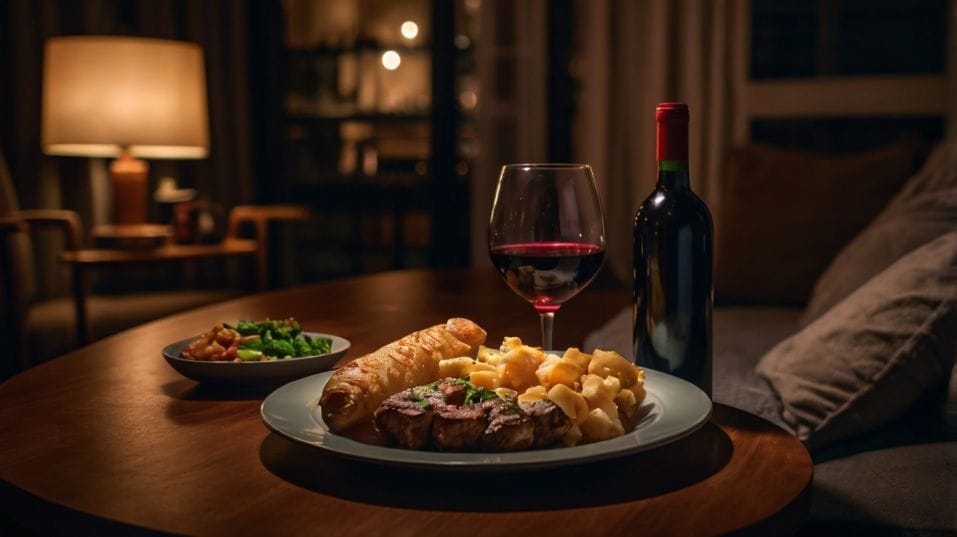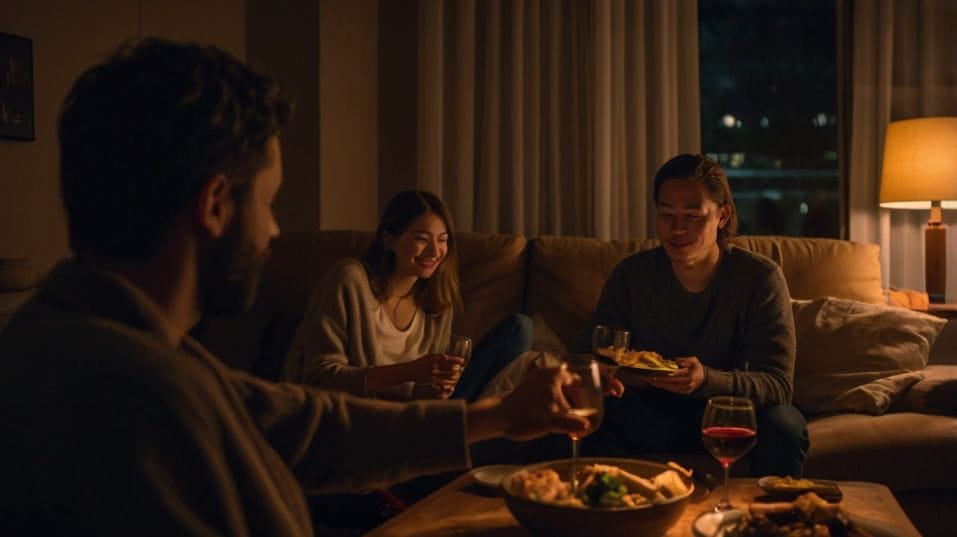Why Wine with Takeout Is Underrated
Discover how pairing wine with takeout can sharpen your palate and boost confidence—no rules, just real flavor that fits real life.

Ever wonder if wine really needs a white tablecloth to shine? It doesn’t. In fact, some of the best wine moments happen with takeout in your lap and chopsticks in hand.
Pairing wine with your go-to pad thai or biryani isn’t just a flex—it’s a fast-track to sharper instincts and better flavor. No rules, no rituals. Just wine that fits your food, your mood, and your real life.
Wine Isn’t Just for Restaurants
If you’ve ever felt unsure about which wine to open at home—or if it even matters when you’re eating something out of a paper bag—you’re not alone.
For a long time, wine has been framed as something you “do properly,” with a three-course meal, the right decanter, and maybe a linen napkin or two. But that lens is outdated.
Most wine drinkers aren’t sitting in tasting rooms or Michelin-starred dining rooms. They’re sitting on their couch with pad thai. Or standing over the counter eating shawarma.
And this is where wine can be most powerful—when you start using it as a companion to what you actually eat, not what some outdated rulebook says you should.
Wine isn’t just for steak and salmon. It’s for Szechuan noodles, Korean fried chicken, lamb biryani, carne asada tacos, spicy tuna rolls.
And once you learn how to work with wine’s structure—not memorized “rules,” but real principles—you start unlocking pairings that make even the most familiar takeout light up in new ways.

Think in Flavor, Not Categories
To pair wine with takeout confidently, stop categorizing by cuisine. Don’t chase stereotypes like “red wine with meat” or “white wine with fish.” Instead, start breaking the dish down by flavor profile and structure.
Take your favorite dish—maybe it’s sesame chicken. What’s happening there? You’ve got sweet soy glaze, crispy texture, a little fat from frying, and maybe some spice if there’s chili oil or hot mustard on the side.
What kind of wine can hang with all that? You want acid. You want freshness. You want something that can match intensity but also reset your palate between bites.
That’s where a bright, juicy white with a little residual sugar—say, a Riesling or a Vouvray—comes alive. Not because of tradition, but because it works.
The same wine that might feel too sweet or casual at a formal dinner becomes laser-focused in the face of salty-sweet, crispy-fried, boldly seasoned takeout.
This is what most wine education leaves out. It’s not about grape names or regions. It’s about contrast, balance, and interaction. About how your food brings out something new in the wine, and vice versa.
Texture Is Your Best Clue
When a wine pairing works, it’s not just about flavor—it’s about how the wine feels with the food. That’s why texture is such a powerful guide. It helps you move beyond categories and start thinking like a taster, not just a shopper.
Don’t Just Taste—Feel
Beyond flavor, the single most useful lens for pairing is texture. Think about how the wine feels, not just how it tastes. Is it light and zippy? Smooth and round? Firm and grippy? Now ask the same questions of your food.
Greasy, fatty, or fried dishes love high-acid wines that cut through richness. Sushi and raw dishes like poke or ceviche pair beautifully with crisp whites or sparkling wines that match their clean, cold textures.
Spicy foods respond best to lower-alcohol wines with gentle tannins and a touch of sweetness. You’re not matching flavor for flavor—you’re managing how food and wine feel together.
This is especially useful when you’re dealing with complex, layered takeout meals that blend sweet, savory, sour, and spice all in one bite. Thai green curry?
The lemongrass and heat call for something cool, aromatic, and a little off-dry—maybe a Gewürztraminer or a chilled Lambrusco. Pork dumplings with chili crisp?
Try a pét-nat or a savory rosé with good acid and subtle fizz. The goal isn’t to match perfectly. It’s to find wines that respond well—like giving your food the right dance partner.
Real-World Wines for Real-World Meals
Most people don’t have a perfectly curated cellar, and they don’t need one. What you do need is a flexible mindset. A willingness to experiment.
A basic understanding of what certain wine styles do—not what they’re called or how prestigious they are. That bottle of Gamay? It’s not just a “light red.”
It’s a secret weapon for everything from Korean BBQ to rotisserie chicken. A chilled Albariño isn’t just for seafood. It sings with anything that’s bright, herbal, or citrusy.
Sparkling wine (dry or off-dry) isn’t a celebration drink—it’s a high-acid, palate-cleansing machine that works with fried foods, spicy foods, and anything you eat out of a foil-lined container.
And once you start paying attention, you’ll notice that your taste sharpens. You start to feel the structure of the wine. You recognize when a pairing falls flat—or clicks. That’s the foundation of real wine knowledge. Not theory. Practice.
From Casual Habit to Confident Ritual
Making wine part of your takeout ritual isn’t just fun—it’s how you train your palate over time.
When you drink wine with a wider range of foods, especially the kinds you eat regularly, you build instinct. You begin to predict what will work, not guess.
You start to taste more clearly. You catch how a red with too much oak steamrolls your food. You realize how much lift a good white brings to salty, spicy dishes.
You stop looking for approval and start tasting with purpose. That’s where real confidence comes from—not reciting facts, but building experience.
And there’s no faster, more practical way to build it than pairing wine with what’s already in front of you. The food you already love. The food that makes up your life.
Final Thoughts
Wine with takeout isn’t a novelty—it’s a gateway. It pushes you to taste more thoughtfully, shop more intentionally, and build the kind of intuitive skill that makes wine less intimidating and more personal.
Forget the rules. Skip the scripts. The next time you order your go-to pad see ew or falafel platter, reach for a bottle with fresh eyes. Think about contrast.
Think about feel. Pour, taste, adjust. That’s how you get better—not by following tradition, but by tasting your way into understanding. Tonight, make one small change. Choose a wine that fits your food.
Not to impress anyone, not to “elevate” the meal, but to experience what wine is actually for: making flavor more vivid, meals more memorable, and everyday life a little more alive.




